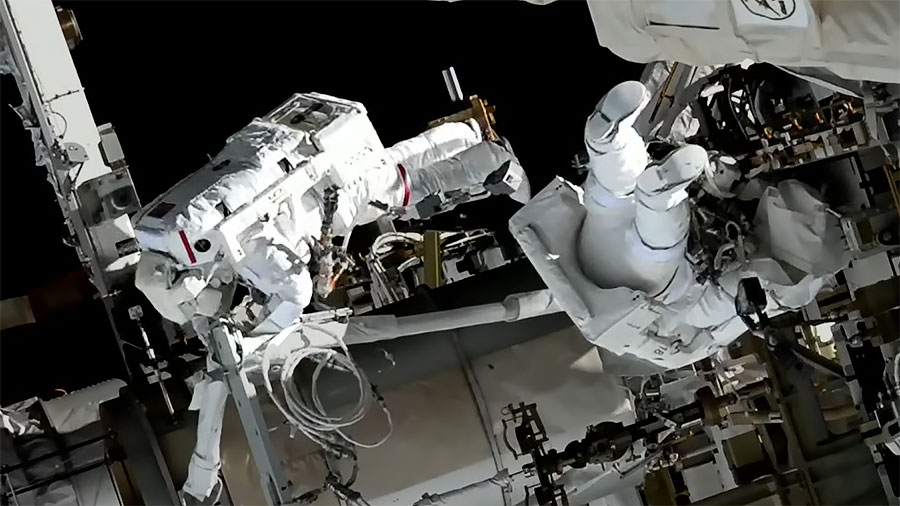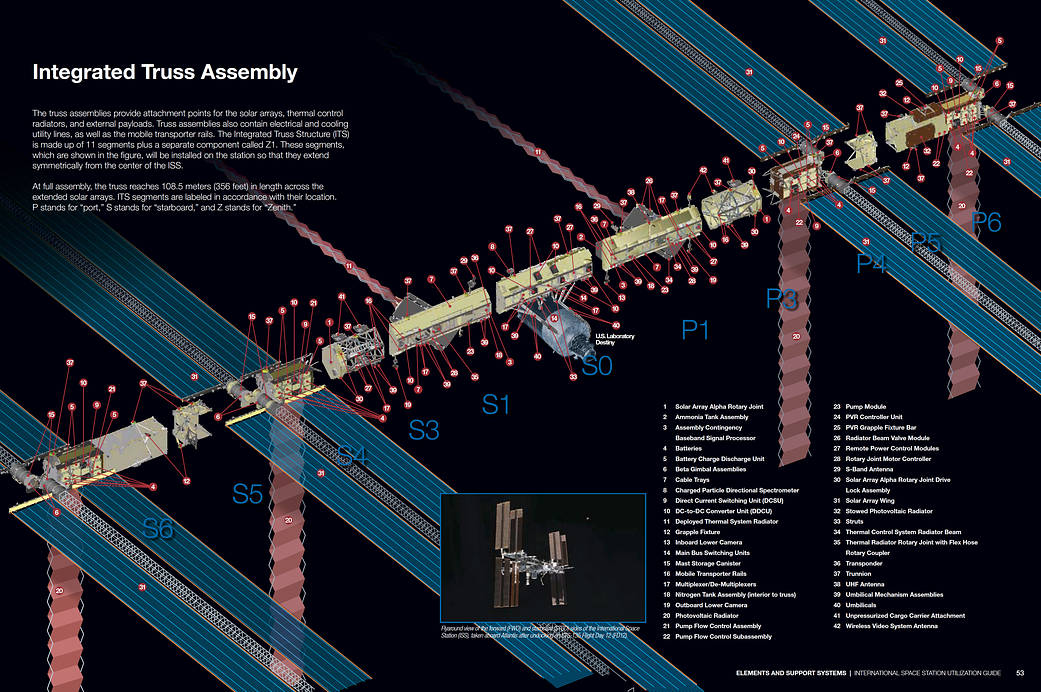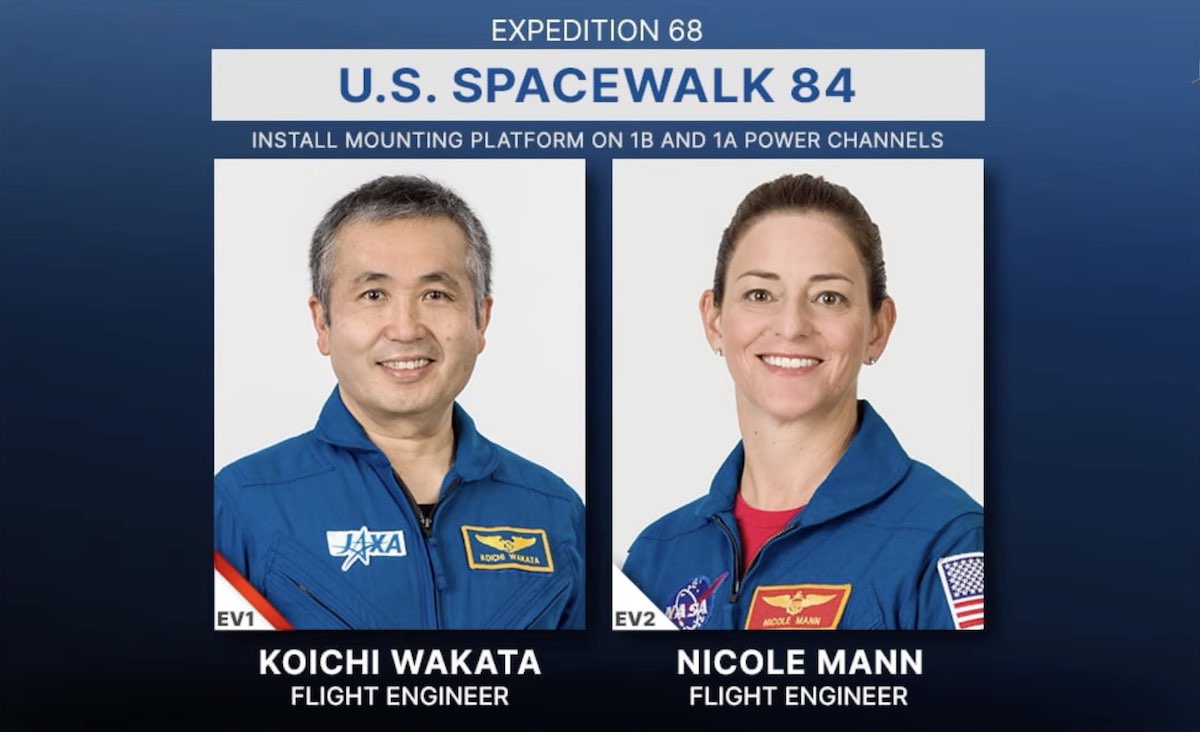Astronauts complete spacewalk to prep for new ISS solar arrays … – Spaceflight Now

Japanese astronaut Koichi Wakata and NASA astronaut Nicole Mann suited up and floated outside the International Space Station Friday for a spacewalk to prepare the lab for arrival of another pair of new solar arrays later this year.
The astronauts switched their spacesuits to internal battery power at 8:14 a.m. EST (1314 GMT) Friday to mark the official start of the spacewalk, the first of the year at the space station. They floated out of the Quest airlock to begin gathering tools and headed to the starboard, or right, side of the station’s power truss.
Wakata and Mann completed the installation of a mounting bracket near one of the space station’s eight existing solar arrays, associated with power channel 1B. Work on that task began on a previous spacewalk. Then the astronauts began to work on attaching a mounting frame for another solar array on power channel 1A.
The two power channels the astronaut worked on Friday are located on the starboard side of the space station’s solar power truss, which extends the length of a football field. Channel 1B is on the S6 truss section at the far right of the power truss, and Channel 1A is located on the next section inward, called S4.
The mounting frames, called modifications kits, will support the attachment of new roll-out solar arrays to be delivered to the space station later this year on a SpaceX Dragon cargo ship. SpaceX has already launched four of the roll-out solar arrays on two previous Dragon resupply missions in June 2021 and in November 2022.
Wakata and Mann finished most of the work to install the modification kit on channel 1B, but due to time constraints, ground teams instructed the astronauts to head back to the airlock before they could finish tightening a bolt on the final strut for the second mounting bracket. That task will be completed on a future spacewalk.
The astronauts began repressurizing the Quest airlock at 3:35 p.m. EST (2035 GMT), marking the end of the 7-hour, 21-minute spacewalk.

The spacewalk Friday was part of a series of excursions to prepare for and install the new International Space Station Roll-Out Solar Arrays, or iROSA units. The iROSA units are built by Redwire, and are designed to augment the space station’s capability to generate electricity as the efficiency of the lab’s original solar panels declines with age.
NASA wants the mounting frame for each new solar array wing to be installed ahead of time. Then the astronauts go out on spacewalks to attach each new roll-out solar array by hand when they arrive on a SpaceX cargo freighter.
NASA astronauts Frank Rubio and Josh Cassada completed two spacewalks in December to install and unfurl the two newest roll-out solar arrays. Station crew members will perform similar work later this year when SpaceX delivers the final two roll-out solar arrays on a cargo mission tentatively set for launch in June.
The roll-out solar arrays launch wrapped around a spool to fit inside the Dragon spacecraft’s cargo trunk. Once deployed, they stretch about 63 feet long and 20 feet wide (19-by-6 meters), roughly half the length and half the width of the station’s original solar panels. The solar array blanket will deploy at a canted angle relative to the original solar panel on each truss, allowing sunlight to illuminate the new and old arrays.
Despite their smaller size, each of the new arrays generate about the same amount of electricity as each of the station’s existing solar panels.

The International Space Station has eight power channels, each fed with electrical power generated from one solar array wing extending from the station’s truss backbone.
The original solar panels launched on four space shuttle missions from 2000 to 2009. As expected, the efficiency of the station’s original solar arrays has degraded over time. NASA is upgrading the space station’s power system with the new roll-out solar arrays — at a cost of $103 million — which will partially cover six of the station’s eight original solar panels.
When all six iROSA units are deployed on the station, the power system will be capable of generating 215 kilowatts of electricity to support at least another decade of science operations. That’s a 30% increase in power generation capability. The enhancement will also accommodate new commercial modules planned to launch to the space station.
The spacewalk Friday was the first in the careers of Wakata and Mann, and the 258th spacewalk overall since 1998 in support of space station assembly and maintenance. Wakata, designated EV1 as the lead spacewalker Friday, is a veteran astronaut on his fifth flight to space. Mann, designated EV2, is on her first spaceflight.
Mann and Wakata launched Oct. 5 on a SpaceX Crew Dragon spacecraft with crewmates Josh Cassada and Russian cosmonaut Anna Kikina. They are scheduled to return to Earth in early March, after the arrival of another team of four astronauts and cosmonauts on SpaceX’s next crew launch.
NASA astronaut Frank Rubio and Russian cosmonauts Sergey Prokopyev and Dmitri Petelin round out the seven-person crew on the International Space Station. They arrived at the space station in September on a Russian Soyuz spacecraft.
Email the author.
Follow Stephen Clark on Twitter: @StephenClark1.





